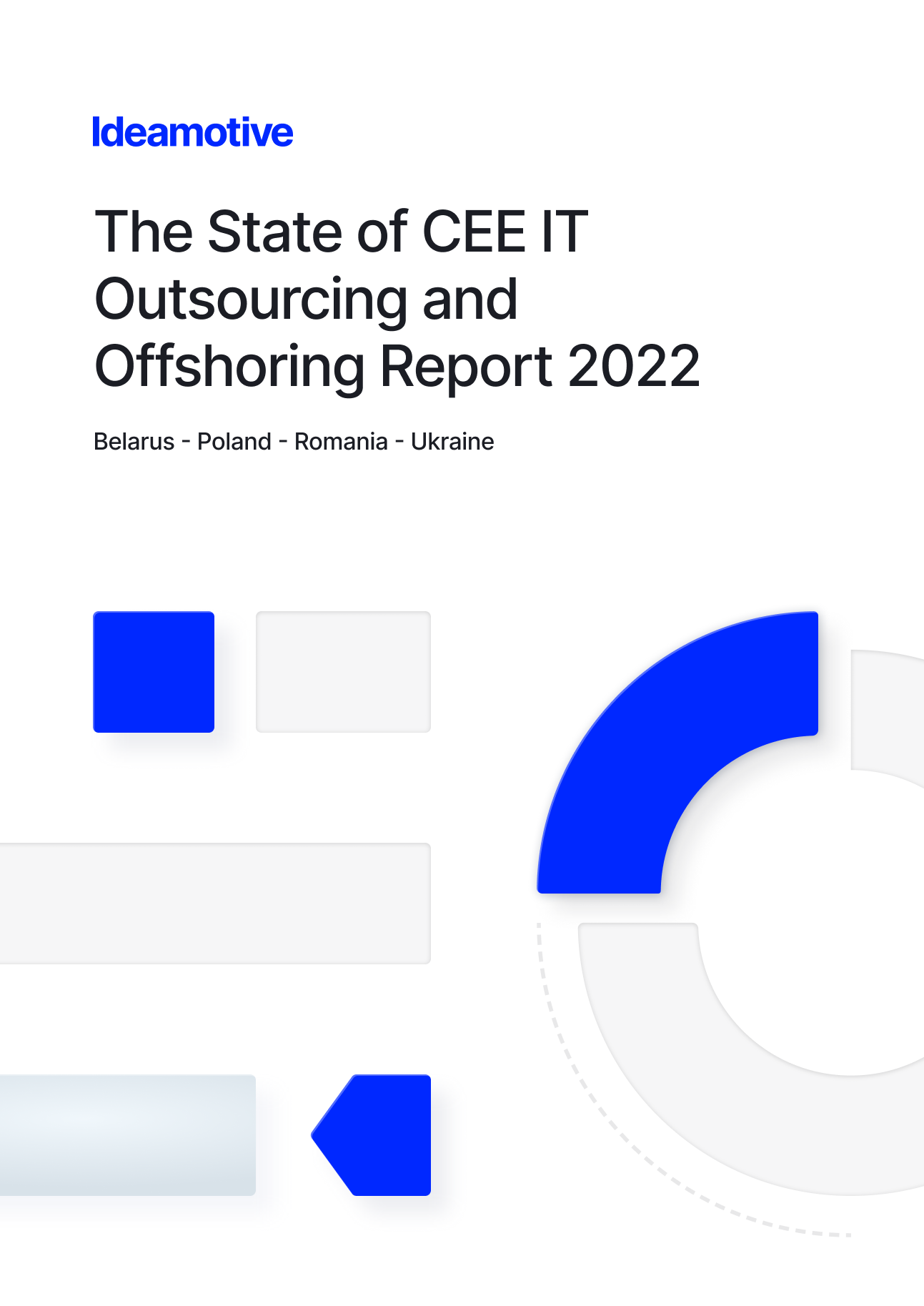Experts' Insights: Factors Affecting Economic Development in Europe Through Technological Advancements
Sep 10, 202415 min read

Cezary Dobrowolski
Tech-savvy marketer and futurologist, focused on blockchain and AI's future in software and marketing, while rejecting traditional corporate marketing methods.

We spoke with leading European experts to understand how technology is influencing economic development across the continent. Through their perspectives, we explore how cloud computing, AI, cybersecurity, and big data are reshaping industries, driving innovation, and strengthening digital resilience. Their insights offer a deeper look into how businesses are adapting to these advancements to stay competitive and secure in an evolving landscape. Join us as we uncover their experiences and learn how these trends might impact the future of your business.
As European enterprises navigate the complexities of digital transformation, cloud computing emerges as a cornerstone of this journey. With nearly half of European businesses adopting cloud services by 2023, the technology is reshaping how organizations operate, innovate, and secure their data. The European Union's ambitious goal of having 75% of enterprises utilize cloud technologies by 2030 underscores the critical role the cloud plays in driving efficiency, scalability, and sustainability across industries.
We delve into the transformative impact of cloud computing on European enterprises, exploring its contributions to sustainable development, data security, and business agility. From enabling small and medium-sized enterprises (SMEs) to compete with more giant corporations to fostering strategic partnerships with cloud service providers, the cloud democratizes access to advanced technologies. It sets the stage for a more resilient and innovative European economy.
The Role of Cloud Computing in the Digital Transformation of European Enterprises
Cloud computing has become a fundamental element of digital strategies in Europe, with 45.2% of enterprises utilizing cloud services in 2023, up from 41% in 2021. The cloud offers flexibility, scalability, and data security, crucial for business operational efficiency and innovation. The European Union actively promotes cloud computing as part of its digital strategy, aiming for 75% of European enterprises to adopt cloud technologies by 2030. Investments in cloud infrastructure, including sustainable and secure edge nodes, are vital for achieving these goals.
Cloud computing contributes to sustainable development by supporting the objectives of the European Green Deal through increased energy efficiency of data centers. In light of growing data security concerns, European enterprises strive to comply with stringent regulations such as the General Data Protection Regulation (GDPR), prompting cloud providers to tailor their services to meet local requirements.
Cloud computing democratizes access to advanced technologies, enabling small and medium-sized enterprises (SMEs) to utilize solutions previously available only to large corporations. SMEs can focus on innovation and growth by eliminating the need for significant infrastructure investments.
Collaboration with cloud service providers (CSPs) and system integrators (SIs) is crucial for successful digital transformation. Enterprises should develop these relationships into strategic partnerships, allowing better alignment of services with business needs and more effective implementation of cloud solutions. Forecasts suggest that the cloud computing market in Poland and Europe will grow at a rate exceeding 20% annually until 2026. This growth is driven by increasing interest in B2B cloud solutions, leading to growing enterprises utilizing these services.
Cloud computing is changing companies' operations, enabling faster responses to market changes and fostering innovation. Businesses are increasingly automating processes and reducing reliance on traditional IT service providers, impacting the traditional technology services market.
When considering migration to the cloud, organizations must carefully evaluate several critical factors, including data security reliability and access to core services as well. This ensures that transition aligns with companies operational goals and risk management strategies. Recent outages among cloud service providers have underscored several critical lessons for both providers and customers of cloud-hosted services:- Need for Redundancy and Diversification: The Microsoft Azure outage in July 2024, which lasted nearly eight hours, had significant global impacts. The incident highlighted the risks of relying too heavily on a single cloud provider. Companies affected by the outage were reminded of the importance of multi-cloud or hybrid-cloud strategies to reduce the risk of service disruptions- Importance of Monitoring and Automation: In July 2024, a major outage caused by a faulty software update from CrowdStrike disrupted services globally. This incident highlighted the necessity for advanced monitoring systems and automated processes that can detect and respond to issues in real time. The rapid spread of the problem showed how crucial it is to have systems that can quickly rollback changes or switch to backup configurations- Access to Core Services and Operability: Cloud migration can enhance service accessibility, but it also makes organizations dependent on the cloud provider's infrastructure. The Azure incident revealed how internal issues within a cloud provider, such as layoffs or technical failures, can affect the availability of critical servicesThese examples highlighted the need for organizations to carefully assess their cloud strategy, ensuring they have robust security, reliable service, and uninterrupted access to meet their operational needs.
Sources:
- https://itwiz.pl/az-557-polskich-przedsiebiorstw-korzysta-z-uslug-cloud-computing/
- https://www.magazynit.pl/cloud-computing/31288-dlaczego-chmura-jest-odporna-na-kryzys.html
- https://inwestycje.pl/biznes/wzrost-rynku-cloud-computing-utrzyma-sie-powyzej-20-r-r-do-2026/
- https://www.ur.edu.pl/files/ur/import/Import/2018/6/20.pdf
- https://ec.europa.eu/eurostat/statistics-explained/index.php?title=Cloud_computing_-_statistics_on_the_use_by_enterprises
- https://www.mckinsey.com/capabilities/mckinsey-digital/our-insights/the-state-of-cloud-computing-in-europe-increasing-adoption-low-returns-huge-potential
- https://telecomrevieweurope.com/articles/cloud-and-enterprise-business/europes-current-digital-sovereignty-focus-on-cloud-computing
- https://digital-strategy.ec.europa.eu/en/policies/cloud-computing
Cybersecurity as a Crucial Element of Economic Stability
European economies increasingly rely on digital technologies across critical transport, energy, health, and finance sectors. This digitalization offers significant opportunities and exposes these sectors to heightened cyber threats. The EU has recognized that as the number of connected devices grows, it is projected to reach 41 billion by 2025. The potential for cyberattacks will increase correspondingly, impacting economic stability and public trust in digital services.
The frequency and sophistication of cyberattacks in Europe have escalated, posing risks to individual businesses and the broader economic framework. Cybercrime can disrupt essential services, undermine consumer confidence, and lead to substantial financial losses. The EU's response includes a commitment to bolster cybersecurity measures to protect its economy and citizens from these threats.
Analyses identify the financial sector, energy and utilities sector, public administration, and transport and logistics as the most vulnerable to cyber threats. Banks and financial institutions are prime targets due to the large amounts of financial data and sensitive customer information they process, leading to significant financial losses and eroded customer trust.
Especially at a time when every average EU citizen is familiar with the provisions of the RODO law regarding the protection of personal data and the resulting rights and obligations incumbent on the data controller and its liability if that data is unlawfully used or stolen.
According to a CERT Polska report, the energy sector faces dual risks from strategic security issues and vast data handling, with 14% of cyberattacks targeting this sector. Public administration institutions, which collect and process citizens' data, are particularly vulnerable, dealing with an average of 15 planned attacks per month. Security gaps and differing cybersecurity approaches among public agencies further facilitate these attacks. Additionally, sectors heavily reliant on networks and IT systems, such as transport and logistics, are highly susceptible to cyberattacks, with disruptions leading to severe economic and social consequences.

Other high-risk sectors include healthcare, pharmaceuticals, telecommunications, retail, and small and medium-sized enterprises. The increasing digitalization of the economy and the growing scale and sophistication of attacks make cybersecurity a critical challenge for Europe's economic stability.
In response to these challenges, the EU has developed a comprehensive cybersecurity strategy to build resilience against cyber threats. This strategy emphasizes the importance of secure communication environments, the protection of critical infrastructure, and the promotion of a cyber-skilled workforce. Significant investments, such as €1.6 billion allocated through the Digital Europe Programme for cybersecurity capacity building and infrastructure deployment, are central to this effort.
Therefore, it is crucial to continuously build awareness and provide knowledge on information security, including cyber security, so that EU citizens have a preventive approach by applying the principle of limited trust to other users of the Internet and computer systems. Very important here is the area of identifying what is an asset, or value, that is subject to protection, whether in one's private life or looking through a professional prism in the organization where one works. The greater the awareness and knowledge of information security, including cybersecurity, the more accurate the analysis in terms of estimating and managing risks and constructing security, which will be minimize this risks.
A robust cybersecurity framework is essential for maintaining economic stability in Europe. By safeguarding critical infrastructure and ensuring the reliability of digital services, the EU can foster a secure environment that encourages investment, innovation, and consumer trust. This is particularly vital as the economy continues to digitalize, making cybersecurity not just a technical issue but a fundamental component of economic strategy and stability.
Sources:
- https://www.consilium.europa.eu/en/policies/cybersecurity/
- https://digital-strategy.ec.europa.eu/en/policies/cybersecurity-policies
- https://www.interface-eu.org/publications/navigating-the-eu-cybersecurity-policy-ecosystem
- https://www.bruegel.org/policy-brief/hybrid-and-cybersecurity-threats-and-european-unions-financial-system
- https://www.cyber-diplomacy-toolbox.com/
- https://www.europarl.europa.eu/topics/pl/article/20211008STO14521/dlaczego-cyberbezpieczenstwo-jest-wazne-i-jakie-sa-koszty-cyberatakow
- https://cyberprofilaktyka.pl/pliki/4-zagrozenia_cyberprzestrzeni_produkt_finalny.pdf
- https://cyberdefence24.pl/cyberbezpieczenstwo/bezpieczny-biznes-i-uslugi-publiczne-ktore-branze-sa-szczegolnie-narazone-na-cyberzagrozenia
- https://emspartner.pl/artykuly/cyberzagrozenia-w-polsce-najbardziej-narazone-branze-i-sektory/
The Significance of Big Data and Data Analytics for Economic Growth
Big Data has the potential to transform various economic sectors, including healthcare, media, energy, and retail. In 2020, the value of the Big Data market in Europe was projected to reach €56 billion, with an annual growth rate of nearly 10%. Companies that effectively leverage data analytics can gain a competitive edge, leading to innovation and operational efficiency.

Data analytics enables the optimization of business processes and real-time decision-making. Utilizing Big Data allows companies to identify patterns and trends, resulting in more accurate forecasts and marketing strategies. For example, in the e-commerce and advertising sectors, data is crucial for personalizing offers and improving customer experiences.
Ensuring high data quality is critical, yet many organizations struggle with incomplete, outdated, or incorrect data, leading to faulty analyses and decisions. Proper data management processes are necessary to maintain data consistency and accuracy. Additionally, Big Data technologies are complex and require advanced IT infrastructure. Organizations must invest in appropriate tools and technologies, such as Hadoop or NoSQL, which involves significant costs and specialized knowledge.
From a social psychology perspective, the increasing cyber threats can trigger concerns about data security and economic stability. The fear of losing privacy and digital security may negatively affect public trust in institutions and their willingness to use digital services. Strengthening cybersecurity measures can not only prevent economic losses but also build a sense of safety among citizens.
Privacy and security concerns also arise from collecting and processing large datasets. In Europe, stringent data protection regulations like GDPR require organizations to manage data cautiously, potentially limiting their ability to utilize Big Data fully. Moreover, there is a need for more qualified employees who can effectively work with data. The growing demand for specialists in data analytics, artificial intelligence, and Big Data necessitates investments in training and skill development. Furthermore, implementing Big Data often requires a cultural shift within organizations, which can be challenging due to resistance to change. Lastly, data regulations in Europe can hinder the full exploitation of Big Data's potential, as complying with legal requirements and navigating complex data-related regulations can restrict organizational flexibility in innovation and adaptation to the changing market.
Sources:
- https://ec.europa.eu/docsroom/documents/13411/attachments/1/translations/en/renditions/native
- https://www.cbi.eu/market-information/outsourcing-itobpo/big-data/market-potential
- https://www.theparliamentmagazine.eu/news/article/big-data-is-future-of-europes-economy
- https://www3.weforum.org/docs/WEF_GITR_Chapter1.8_2015.pdf
- https://link.springer.com/chapter/10.1007/978-3-319-21569-3_1
- https://www.europarl.europa.eu/pdfs/news/expert/2021/2/story/20210211STO97614/20210211STO97614_pl.pdf
- https://www.europarl.europa.eu/topics/pl/article/20210211STO97614/big-data-definicja-korzysci-wyzwania-infografika
The Development of the Internet of Things (IoT) and Its Economic Impact on Europe
The Internet of Things (IoT) refers to a network of physical objects that can communicate and exchange data via the Internet. The concept was first named in 1999 by Kevin Ashton, who proposed using RFID chips to track products in the supply chain. Understanding the history of IoT, from early examples like a remotely monitored vending machine in the 1980s to contemporary applications, is crucial for grasping its current state and future.
Economic Impact of IoT in Europe
IoT can transform many economic sectors, including industry, transport, healthcare, and urban management. In 2019, approximately 25% of European companies used IoT technology, a significant increase from previous years. By 2025, the number of IoT devices is expected to reach 41.6 billion, highlighting the growing role of this technology in daily life and the economy.
The application of IoT can lead to increased operational efficiency, cost savings, and better resource management. Examples include smart energy grids that optimize energy consumption and health monitoring systems allowing remote patient management. However, the development of IoT also comes with challenges, such as security and privacy issues, which can affect public trust in these technologies.
The expansion of IoT technology has led to significant benefits, such as improved efficiency and cost savings, but it also raises critical cybersecurity concerns. Many IoT devices lack robust security features due to their limited processing power, making them vulnerable to cyberattacks. Hackers can exploit these weaknesses, leading to data breaches and unauthorized control of devices, which is particularly concerning given the vast amounts of personal data these devices collect.In addition, the decentralized nature of IoT networks, with many different devices operating in different locations and conditions, complicates security efforts and requires tailored strategies for each environment. To address these challenges and mitigate potential risk and attack vectors, IoT devices must be designed with security in mind, supported by regular updates adhering to industry and regulatory standards and requirements. Only by effectively managing these cybersecurity risks can the full potential of the IoT be realized, without compromising public trust.
Future of IoT in Europe
As IoT technology evolves, its impact on European economies will likely grow. Key factors will include understanding and managing security risks and developing regulations that support innovation while protecting citizens.
In Europe, numerous significant IoT applications impact various sectors and daily life. Here are the most important examples:

Sources:
- https://www.telko.in/europejskie-wydatki-na-iot-z-12-proc-cagr-do-2027-roku
- https://digital-strategy.ec.europa.eu/pl/policies/internet-things-policy
- https://efl.pl/pl/biznes-i-ty/artykuly/dominujace-sektory-gospodarki
- https://www.sustainabilityenvironment.com/2024/04/19/europe-is-the-biggest-market-for-iot-applications-for-smart-cities/
- https://www.cbi.eu/market-information/outsourcing-itobpo/industrial-internet-things/market-potential
- https://www.businessmarketinsights.com/reports/europe-iot-market
The Role of 5G Technology in Accelerating Economic Growth
5G technology represents a significant advancement over previous generations, offering data transfer speeds up to 100 times faster than 4G, ultra-low latency, and the ability to connect many devices simultaneously. These features make 5G a catalyst for innovation across various industries, including healthcare, automotive, agriculture, and urban development.
5G is projected to boost economic growth by enhancing efficiency and productivity across multiple sectors. In healthcare, it could lead to better patient outcomes and lower costs through innovations like remote monitoring and telemedicine. Small and medium-sized enterprises (SMEs) are expected to play a crucial role in the 5G ecosystem, using the technology to develop and implement innovations, enhancing their participation in the digital economy and driving competitiveness. Different sectors will experience varying levels of economic uplift, with the healthcare sector alone expected to add over $530 billion to global GDP by 2030 due to 5G applications.
The development of 5G technologies is critical for Europe to maintain its strategic autonomy in the global market. By investing in 5G infrastructure and innovation, Europe can ensure a diverse and competitive telecommunications landscape. The European Commission has committed significant funding to support 5G research and deployment through initiatives like the 5G Action Plan, aiming to ensure widespread coverage across EU member states. This investment is essential for meeting individuals' and industries' increasing connectivity demands.
5G is not just about connectivity; it also serves as a foundation for future technologies such as the Internet of Things (IoT), artificial intelligence (AI), and edge computing. When combined with 5G, these technologies can unlock new business models and enhance service delivery across various sectors.

Sources:
- https://www.eib.org/attachments/thematic/accelerating_the_5g_transition_in_europe_summary_en.pdf
- https://digital-strategy.ec.europa.eu/en/policies/5g
- https://www.pwc.com/gx/en/tmt/5g/global-economic-impact-5g.pdf
- https://www.qualcomm.com/content/dam/qcomm-martech/dm-assets/documents/accenture_5g_economic_impact_us_eu_overview_slides.pdf
- https://businessinsider.com.pl/technologie/nowe-technologie/5g-w-biznesie-to-nie-rewolucja-ale-zmieni-w-naszym-zyciu-wiele/vpkzn3t
- https://www.accenture.com/content/dam/accenture/final/a-com-migration/manual/r3/pdf/pdf-144/Accenture-5G-WP-EU-Feb26.pdf
- https://op.europa.eu/webpub/eca/special-reports/security-5g-networks-03-2022/en/
- https://www.qualcomm.com/eu/5g-economy
The Impact of Artificial Intelligence on Economic Development
Obviously, AI is expected to boost economic growth in Europe significantly. Estimates suggest that AI could contribute approximately €15.7 trillion to the global GDP by 2030, with a notable portion of this growth occurring in Europe due to its proactive regulatory environment and investment in AI technologies. Generative AI is projected to enhance productivity by up to $1 trillion by 2026, highlighting its potential to transform business operations and economic output.
While AI is likely to displace around 85 million jobs by 2025, it is also expected to create approximately 97 million new jobs in data science and robotic process automation areas. This dual impact underscores the necessity for workforce reskilling and adaptation to new roles. Different sectors will experience varying levels of AI adoption and impact. Industries heavily reliant on routine tasks may face more significant job losses, while sectors like healthcare and technology could see job creation and enhanced efficiency.
The uneven distribution of AI capabilities across European regions presents challenges and opportunities. Some countries may advance rapidly, while others may lag, potentially exacerbating economic inequalities within the EU. Speculating on the long-term implications of AI on economic development includes potential increases in inequality and unemployment, as well as the need for policies that promote inclusive growth and equitable access to technology.
The application of AI in Europe brings significant economic benefits, contributing to economic growth in the coming years. Capital investments and productivity benefits can globally add between $1.2 to $2.4 trillion in additional production value over a decade. In Poland, AI could generate value equivalent to the work of nearly 5 million people, valued at $90 billion annually, placing the country 7th among the economies of the EU, USA, UK, and Switzerland in terms of productive capacity generated by this technology. AI can help businesses create innovative products and services, particularly in energy, security, and healthcare, with notable benefits in healthcare, the environment, and combating disinformation.
AI can support workers in analyzing and monitoring data, planning operations, reviewing documents, design work, and safety control processes. AI effectively frees workers from performing monotonous and time-consuming tasks, such as translations, transcriptions, data compilations, and creating summaries. In summary, the application of AI in Europe has the potential to significantly increase productivity, develop innovative solutions, and improve production efficiency, leading to economic growth and benefits for businesses and the overall economy.
Artificial intelligence is transforming the economic landscape, but from the perspective of occupational psychology, it is crucial to understand how these changes affect employees. Introducing AI may lead to concerns about job security, potentially lowering employee morale and engagement. On the other hand, AI can relieve workers from routine tasks, allowing them to focus on more creative and strategic activities, which promotes personal and professional growth. For example, our research has shown that contrary to appearances, employees of Polish companies performing manual tasks are among those most supportive of automation and robotization. It is therefore worth relying on employee attitude studies in any transformation.
Sources:
- https://www.ey.com/pl_pl/news/2024/05/ey_wired_for_ai_pl
- https://cyfrowa.rp.pl/biznes-ludzie-startupy/art39546101-europa-wyrasta-na-lidera-w-sztucznej-inteligencji-o-tych-firmach-bedzie-glosno
- https://commission.europa.eu/strategy-and-policy/priorities-2019-2024/europe-fit-digital-age/excellence-and-trust-artificial-intelligence_pl
- https://businessinsider.com.pl/gospodarka/sztuczna-inteligencja-moze-nam-dac-dodatkowe-8-proc-pkb/90h6sjz
- https://cepr.org/voxeu/columns/impact-artificial-intelligence-growth-and-employment
- https://www.eca.europa.eu/ECAPublications/ECA-AI-Strategy-2024-2025/ECA-AI-Strategy-2024-2025_EN.pdf
The Growth of E-Commerce and Its Impact on the European Economy
E-commerce has experienced significant growth globally, with projections indicating that retail e-commerce sales will surpass $8 trillion by 2027, reflecting a 39% increase over the coming years. In 2023, e-commerce accounted for over 19% of total retail sales worldwide, and this figure is expected to rise to approximately 23% by 2027. This growth significantly impacts the European economy.
The European e-commerce market is rapidly expanding, driven by increasing internet penetration and changing consumer habits. This growth extends beyond traditional retail to various sectors, including B2B, B2C, and C2C transactions. European consumers increasingly favor online shopping due to its convenience and accessibility, with mobile commerce expected to account for 62% of all retail sales by 2027. This shift in consumer behavior is prompting traditional brick-and-mortar stores to reevaluate their retail strategies across Europe. E-commerce contributes significantly to the European economy by creating jobs, fostering innovation, and enhancing business competitiveness. The sector supports various industries, including logistics, technology, and customer service.
However, e-commerce also presents challenges, such as cybersecurity risks, regulatory compliance, and the need for businesses to adapt to rapidly changing technologies. Companies must invest in robust digital infrastructures and customer engagement strategies to thrive in this competitive landscape. Additionally, e-commerce facilitates cross-border trade within Europe, allowing businesses to reach a broader customer base. This trend is particularly beneficial for small and medium-sized enterprises (SMEs) looking to expand their market presence without substantial investments in physical infrastructure.
The Role of IT in Crisis Management and Economic Resilience
Crisis management involves four key phases: preparedness, response, mitigation, and recovery, with IT playing a critical role in each. Technology enhances risk assessment and preparedness in early warning systems, using simulation tools and predictive analytics to improve readiness. Real-time data sharing and GIS communication tools facilitate effective agency coordination during the response phase.
In mitigation, IT identifies vulnerabilities and implements risk-reduction measures through data analysis and IoT devices. For recovery, technology aids in restoring services and infrastructure, using data management systems to track progress and digital platforms to assist affected populations. Communication technologies, including social media, provide real-time updates during crises, enhancing situational awareness and public safety, though traditional methods should also be maintained for reliability.
Interoperability among emergency services across borders is crucial, with standard management plans and data-sharing systems improving crisis response. The EU's Civil Protection Mechanism and Integrated Political Crisis Response (IPCR) arrangements foster cooperation among member states, ensuring a unified response. Effective crisis management and IT integration are essential for economic recovery, as seen during the COVID-19 pandemic, with remote work, telemedicine, and online education maintaining economic activity.
Modern crises are complex and cross-border, requiring adaptive strategies and evolving technology reliance. Innovations in AI, machine learning, and blockchain offer new crisis management tools while robust cybersecurity measures protect against digital disruptions. Crisis management strategies must be sustainable and equitable, addressing digital divides and ensuring all communities can access necessary resources and technologies.
The Impact of Legal Regulations on the IT Sector in Europe
The rise in digital security regulations, such as the Cyber Resilience Act, forces companies to adapt to new standards for data protection and IT systems security. Businesses must be prepared for new requirements regarding cybersecurity incident prevention and response. Additionally, new regulations foresee the creation of "regulatory sandboxes" for small and medium-sized enterprises (SMEs) to foster innovation in AI. These sandboxes allow SMEs to test new technologies in a controlled environment, promoting innovation and reducing compliance burdens.
As these regulations come into force, the IT sector in Europe will need to adjust its operational strategies. Companies must comply with new laws and actively discuss future legislative changes to ensure that regulations support rather than hinder innovation. In 2023, nearly 10 million IT specialists were employed in the European Union, accounting for about 5% of total employment. This represents a notable increase, with the share of IT specialists in employment rising by 1.5% since 2013. Despite 91% of people in the EU using the internet and 56% having basic or higher digital skills, only 22% of companies in the EU offered training in ICT skills, indicating a need for further development in this area.
Forecasts indicate that IT spending in Europe will increase by 9.3% in 2024, reaching $1.1 trillion. New legal regulations and growing demand for digital services likely drive this significant rise in digital technology investments. Poland's IT sector is also growing dynamically, with legal regulations significantly shaping its landscape. In 2023, around 400,000 IT specialists were employed in Poland, representing a substantial part of the labor market. The increasing number of tech startups and investments in innovation support this growth.
Sources:
- https://ec.europa.eu/eurostat/de/web/interactive-publications/digitalisation-2024
- https://statista.com/forecasts/960953/it-revenue-segments-in-europe
- https://www.gartner.com/en/newsroom/press-releases/2023-11-09-gartner-forecasts-it-spending-in-europe-to-record-9-percent-growth-in-2024
- https://ec.europa.eu/eurostat/web/products-eurostat-news/w/wdn-20240429-1
- https://www.eversheds-sutherland.com/en/netherlands/insights/eu-and-uk-technology-law-shorts-june-2024
- https://www.whitecase.com/insight-alert/long-awaited-eu-ai-act-becomes-law-after-publication-eus-official-journal

Cezary is a tech enthusiast and musician, passionate about the future of blockchain and AI in software, marketing, and sales. He opposes traditional corporate approaches and explores futurology in his private life.
View all author posts
Never miss an issue!
Get notified as soon as the next Experts' Insights is out.
Trending articles
21 Dazzling Examples of Mobile App UI Design to Inspire You in 2023
Michał Pruciak 7 min read
MedTech vs HealthTech vs BioTech: What Are The Differences?
Michał Pruciak 7 min read
10 Business Applications of Neural Network (With Examples!)
Michał Pruciak 4 min read
Best React Native Boilerplates to Use In 2023
Michał Pruciak 6 min read
10 Irresistible Examples of Web Design Best Practices for 2023
Adam Kozłowski 7 min read

The State of Central & East Europe IT Outsourcing and Offshoring 2024 Report
Belarus • Poland • Romania • Ukraine
Read nowRead more related articles:
Seamless and fast alignment of the right tech talent with Your evolving needs
We take care of formalities, hiring and matching services, so that you can focus on your product.
Rated 4.8 / 5.0 by clients from various industries and locations.







